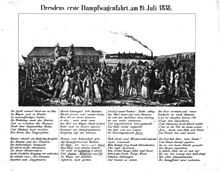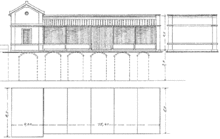Radebeul-Weintraube stop
| Radebeul grapes | |
|---|---|
|
Central platform between the S-Bahn tracks,
on the right the long-distance train tracks (2014) |
|
| Data | |
| Operating point type | Breakpoint |
| Platform tracks | 2 |
| abbreviation | DRBT |
| IBNR | 8012700 |
| Price range | 6th |
| opening | July 19, 1838 |
| Profile on Bahnhof.de | Radebeul grapes |
| location | |
| City / municipality | Radebeul |
| country | Saxony |
| Country | Germany |
| Coordinates | 51 ° 6 '11 " N , 13 ° 39' 21" E |
| Railway lines | |
|
|
| Railway stations and stops in Saxony | |
The Radebeul-Weintraube stop is an operating point on the Pirna – Coswig railway line in Radebeul . 1838 lay there in the field of Lößnitz towns the first breakpoint of Germany's oldest long-distance railway line Leipzig-Dresden , seen from Dresden: the station grape , which is the oldest regularly operated at the same location breakpoint in Saxony today.
history
The construction of the long-distance railway connection Leipzig – Dresden , established from 1837 to 1839, was started by both sides at the same time. The 8.18 km long section from Dresden-Neustadt to Weintraube was ceremoniously opened on July 19, 1838, at the same time the first " station " in what is now Radebeul's urban area was inaugurated near the royal Hoflößnitz winery near today's Radebeul-Weintraube train station , including the first hub to Dresden. In reference to the nearby Zur Weintraube winery and inn, the stop was named Weintraube . The innkeeper took the opportunity to open a branch of his restaurant right next to the railway, the Kleine Weintraube .
By the end of August of that year, 68,000 people had already used the “steam trip” to the Lößnitz, which was stated on the contemporary lithograph opposite to take twelve minutes for “forwards and backwards”. The following locomotives are named: Blitz , Bury and Comet , and passenger cars: Guttenberg, Gustav, Wittekind and Tell.
On September 16, 1838, the 13.44 km long section Weintraube via Coswig to Oberau was opened in front of the tunnel at that time . After the opening of the entire Leipzig – Dresden line in 1839, double-track was established on the entire line by 1840 and the station in Kötzschenbroda ( Radebeul-Kötzschenbroda stop ) also opened downstream in 1840 , and the one in Radebeul ( Radebeul Ost station ) opposite Dresden in 1860 . These last two stations were later also given traffic facilities for freight traffic.
The first waiting hall in the Lößnitz was built at the Weintraube station , but after the introduction of legal proceedings in 1883 and tunneling under the railway body in 1887, it had to be replaced by a new building, which was demolished in 1972.
In Weintraube as well as in Kötzschenbroda, trains only stopped on certain days in the first few years. The Kötzschenbrodaer timetable from 1876 shows that not all of the 37 daily trains also stopped in Weintraube , some of them only “as needed”.
The court conductor Ernst von Schuch , who lives in nearby Niederlößnitz , traveled by train from the Weintraube station to work for many years. A special train was set up especially for him, popularly known as the "Schuch train", which ran at rehearsal times.
In 1900 the four-track expansion of the railway line began. On May 1, 1904, the breakpoint was given the name of the surrounding village of Serkowitz and on May 1, 1905, after Serkowitz was incorporated into Radebeul, it was given the original name of grape again . Since May 15, 1934, the site has been called Radebeul-Weintraube .
After the Second World War, all tracks except the southern one were dismantled in the course of reparations payments, leaving only one platform in operation. Only a few trains stopped there, and long-distance trains from one direction were often bundled and sent over the single-track route.
At the beginning of the 1960s, the northern track was relocated to create a future three-track system, and in the middle between them a track with a correspondingly large clearance delimitation for Soviet wide-gauge wagons (gauge 1520 mm). The worn southern track was demolished. From 1982 the southern track was relocated, and then the other two were renovated. The middle track could be used for trains in both directions, but due to the lack of a platform they could not stop in Radebeul Weintraube . Because of the location of the switches, all traffic to the west was routed via the northern track and that going to Dresden via the southern track. The middle track was used by fast-moving trains in the west as an overtaking track, and in the direction of Dresden as a regular track.
From 2010 to February 5, 2012, the stop was not served without replacement, as only one track was available due to construction work and the resulting timetable constraints did not allow a stop. All trains passed through the area without stopping at up to 120 km / h.
Today only the S 1 trains of the Dresden S-Bahn stop in Radebeul-Weintraube .
construction
Between February 5, 2012 and November 17, 2013, the Radebeul-Weintraube stop consisted of two makeshift platforms on the later long-distance tracks. Today the stop has a central platform with an elevator and stairs to an underpass.
literature
- Frank Andert (Red.): Radebeul City Lexicon . Historical manual for the Loessnitz . Published by the Radebeul City Archives. 2nd, slightly changed edition. City archive, Radebeul 2006, ISBN 3-938460-05-9 .
- Heinz Hoffmann: Radebeul Railway History . In: Association for Monument Preservation and New Building Radebeul (ed.): Contributions to the urban culture of the city of Radebeul . Radebeul 2006.
Web links
- Location, track systems, signals and permissible speeds on the OpenRailwayMap
- Photos of Radebeul-Weintraube on sachsenschiene.net
Individual evidence
- ^ A b Royal Saxon State Railroad Direction to Dresden; Timeline: Establishments - Designations - Dissolutions , accessed on June 20, 2012.
- ^ Karl Julius Hofmann: The Meissen Netherlands in its natural beauties and peculiarities or Saxon Italy in the Meissen and Dresden areas with their localities. A folk book for nature and patriot friends presented topographically, historically and poetically . Louis Mosche, Meißen 1853, p. 713 f. ( Digitized in the Google book search)
- ↑ Also documented in: Rolf Bayer: Die Wagen. In: Fritz Borchert (Ed.): The Leipzig-Dresden Railway. Beginnings and present of a 150 year old. transpress VEB Verlag für Verkehrwesen , Berlin 1989, ISBN 3-344-00354-2 , pp. 125-144.
- ^ A b Heinz Hoffmann: Radebeul Railway History . In: Association for Monument Preservation and New Building Radebeul (ed.): Contributions to the urban culture of the city of Radebeul . Radebeul 2006.
- ↑ Individual station buildings: built in 1898. In: sachsenschiene.net
- ↑ Gert Morzinek: Historical forays with Gert Morzinek. The collected works from 5 years “StadtSpiegel” . premium Verlag, Großenhain 2007, p. 236 ff.
- ↑ Data on www.sachsenschiene.net






